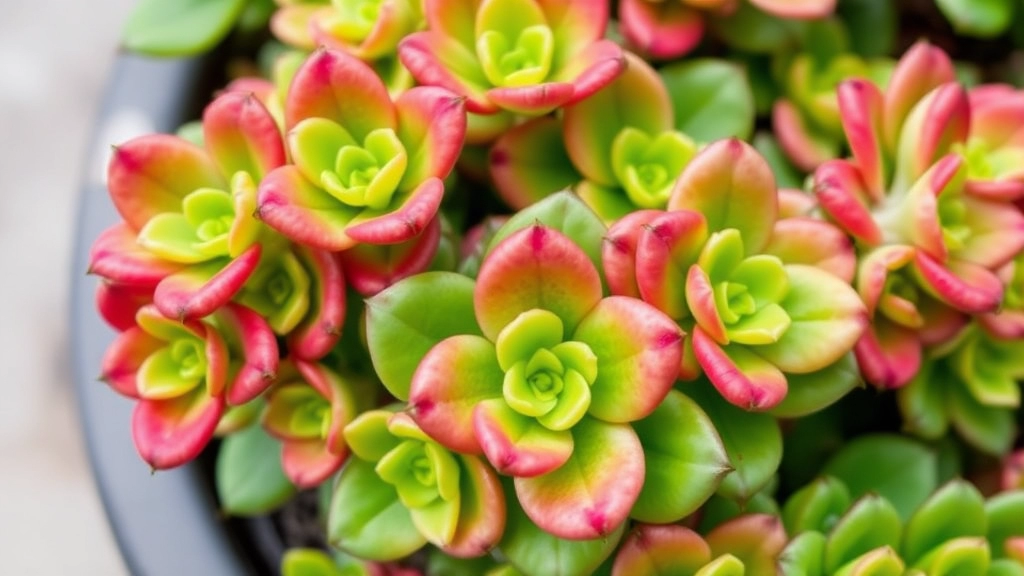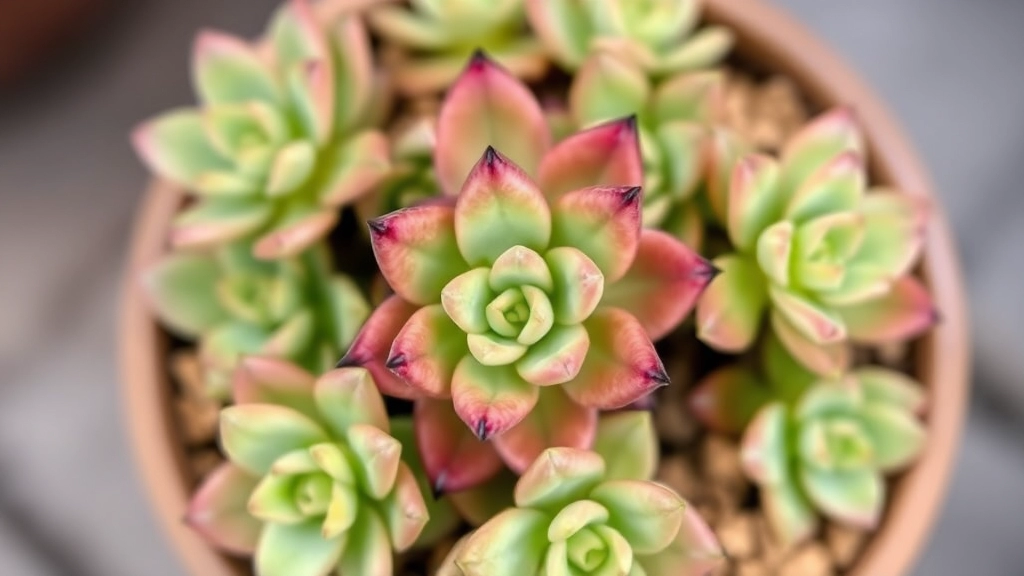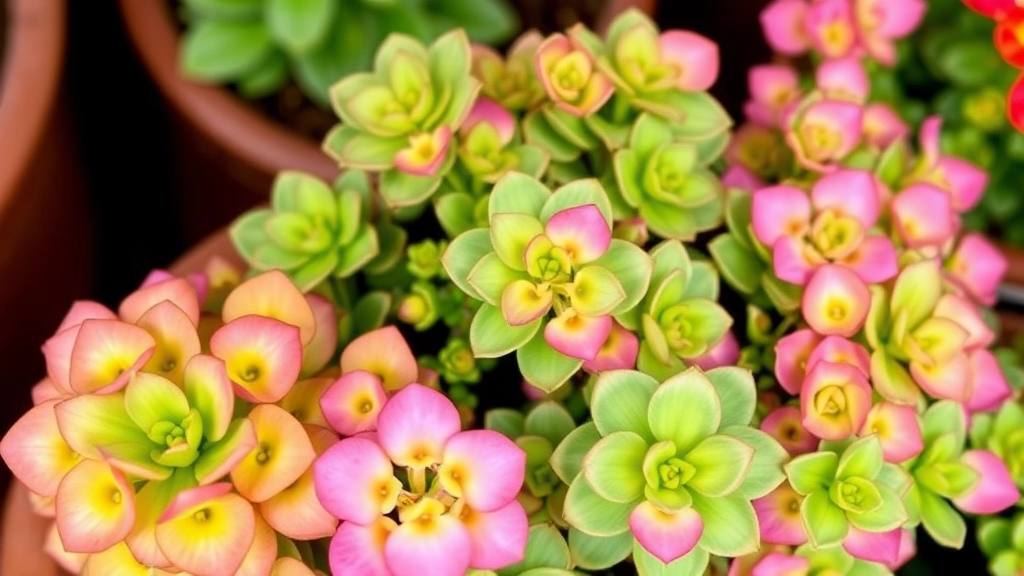Exploring Green Kalanchoe Varieties
When it comes to green Kalanchoe varieties, there’s a fascinating array to explore. These succulents are not only visually appealing with their lush green foliage but also relatively easy to care for. In this article, I’ll take you through some popular green Kalanchoe varieties, highlighting their unique features and care requirements.
Whether you’re an indoor gardening enthusiast or looking to add some greenery to your outdoor space, green Kalanchoe plants offer versatility and charm. I’ll also share tips on how to maintain these succulents, ensuring they thrive in various conditions. Ready to discover the best green Kalanchoe varieties for your garden? Let’s dive in!
Popular Green Kalanchoe Varieties to Know
When it comes to choosing the right Kalanchoe for your space, the variety you select can make all the difference. You might be wondering which green Kalanchoe varieties are worth your attention.
- Kalanchoe luciae (Paddle Plant)
This striking succulent features thick, paddle-shaped leaves that can take on a reddish hue at the edges when exposed to sunlight. Its vibrant green foliage is a standout, making it a popular choice for both indoor and outdoor gardens. - Kalanchoe tomentosa (Panda Plant)
Known for its fuzzy, grey-green leaves with brown edges, the Panda Plant adds a unique texture to your collection. This variety is not only visually appealing but also easy to care for, making it perfect for beginners. For more detailed care instructions, check out our Panda Plant care guide. - Kalanchoe beharensis (Felt Plant)
With its large, felt-like leaves, this variety offers a distinctive look. The soft, green foliage can grow impressively large, adding an eye-catching element to your indoor garden. Learn more about how to care for this variety in our Kalanchoe beharensis care guide. - Kalanchoe pinnata (Air Plant)
Also known as the “Mother of Thousands,” this variety is known for its ability to produce tiny plantlets along the edges of its leaves. Its lush green foliage makes it a popular choice for those looking to propagate their plants easily. - Kalanchoe ‘Flapjacks’
This variety features thick, flat leaves that resemble pancakes. Its vibrant green colour can brighten up any space, making it a favourite among succulent enthusiasts.
These popular green Kalanchoe varieties not only enhance the aesthetic of your garden but also offer unique features that cater to different gardening preferences.
Unique Features of Green Foliage in Kalanchoe Plants

Have you ever marveled at the lush green leaves of Kalanchoe plants?
These beauties aren’t just about their vibrant blooms; their foliage has some unique features that make them stand out.
1. Varied Leaf Shapes
Kalanchoe leaves come in different shapes and sizes.
- Round: Some varieties have plump, round leaves that almost look like little coins.
- Pointed: Others sport elongated, pointed leaves that add a touch of elegance.
2. Textured Surfaces
The texture of Kalanchoe leaves can be quite fascinating.
- Smooth: Many have smooth surfaces that feel nice to the touch.
- Waxy: Some varieties have a waxy coating, which not only looks appealing but also helps retain moisture.
3. Colour Variations
While we’re focusing on green foliage, it’s worth noting that the shades of green can vary significantly.
- Bright Green: Some leaves are a vibrant, almost neon green.
- Dark Green: Others lean towards a deep, rich green, offering a striking contrast.
4. Edges and Margins
The edges of Kalanchoe leaves can tell you a lot about the variety.
- Smooth Edges: Some have clean, smooth edges, giving them a sleek appearance.
- Fringed or Serrated: Others may have serrated or fringed edges, adding character to the plant.
5. Growth Habit
Kalanchoe plants often exhibit interesting growth patterns.
- Compact: Some varieties stay small and compact, perfect for indoor spaces.
- Sprawling: Others may spread out, making them great for ground cover or hanging baskets.
Green Kalanchoe Varieties Suitable for Indoor Gardening
Are you looking to bring some greenery into your home? Green Kalanchoe varieties are a fantastic choice for indoor gardening. Their vibrant foliage and easy care make them ideal companions for both seasoned gardeners and beginners alike.
Care Tips for Maintaining Green Kalanchoe Succulents

Maintaining green Kalanchoe succulents can seem daunting, but with the right approach, it can be a rewarding experience. Many plant enthusiasts worry about overwatering or inadequate light, which can lead to unhealthy plants. Here are some straightforward care tips to keep your Kalanchoe thriving.
Watering
- Frequency: Water your Kalanchoe only when the top inch of soil feels dry. This usually means every 2-3 weeks, depending on the season.
- Technique: Use the soak-and-dry method. Water thoroughly, allowing excess to drain out, then let the soil dry completely before the next watering.
Light Requirements
- Ideal Conditions: Green Kalanchoe prefers bright, indirect sunlight. A south or east-facing window is ideal.
- Signs of Insufficient Light: If your plant starts to stretch or become leggy, it may need more light.
Soil Type
- Well-Draining Mix: Use a cactus or succulent potting mix. This ensures proper drainage, preventing root rot.
- DIY Option: You can create your own mix by combining regular potting soil with sand or perlite.
Temperature and Humidity
- Optimal Range: Kalanchoe thrives in temperatures between 18°C to 24°C. Avoid exposing it to cold drafts.
- Humidity Levels: These plants prefer low humidity, making them perfect for indoor environments.
Fertilisation
- Frequency: Fertilise during the growing season (spring and summer) every 4-6 weeks with a balanced, diluted fertiliser.
- Type: A succulent-specific fertiliser is best, as it provides the nutrients without overwhelming the plant.
Pruning and Maintenance
- Removing Dead Leaves: Regularly check for and remove any dead or yellowing leaves to promote healthy growth.
- Encouraging New Growth: Pinch back leggy stems to encourage bushier growth.
Best Conditions for Green Kalanchoe Growth Outdoors
When considering the best conditions for green Kalanchoe growth outdoors, it’s essential to understand their natural habitat. These succulents thrive in environments that mimic their native settings.
Key Factors for Outdoor Growth:
- Sunlight:
- Green Kalanchoe plants require bright, indirect sunlight.
- Aim for at least 6 hours of filtered sunlight daily.
- Soil Type:
- A well-draining soil mix is crucial.
- Consider using a cactus or succulent-specific potting mix to prevent root rot.
- Temperature:
- Ideal temperatures range from 20°C to 30°C.
- Protect your plants from frost, as they are sensitive to cold.
- Watering:
- Water only when the top inch of soil is dry.
- Overwatering can lead to root issues, so less is often more.
- Humidity:
- Kalanchoe prefers low humidity levels.
- If you live in a humid area, ensure good air circulation around the plants.
By providing these optimal conditions, your green Kalanchoe will flourish outdoors, showcasing its vibrant foliage and unique charm. For more specific tips on soil and watering, check out this guide on watering Kalanchoe. Additionally, understanding the comprehensive care for Kalanchoe can further enhance your plant’s growth.
Propagation Methods for Green Kalanchoe Varieties
So, you’re keen on expanding your green Kalanchoe collection?
Let’s dive into some easy and effective propagation methods that will have your plants multiplying in no time.
1. Leaf Cuttings
This is one of the simplest ways to propagate Kalanchoe, and it’s super satisfying. Here’s how to do it:
- Select a Healthy Leaf: Choose a plump, healthy leaf from your Kalanchoe.
- Cut the Leaf: Use a clean, sharp knife to cut the leaf at the base.
- Let It Callous: Place the leaf on a dry surface for a couple of days to let the cut end callous over. This helps prevent rot.
- Plant the Leaf: Once calloused, lay it flat on well-draining soil and lightly press it down.
- Water Sparingly: Mist the soil lightly, but don’t soak it. Keep it just moist.
2. Stem Cuttings
If you’ve got a Kalanchoe that’s getting a bit leggy, stem cuttings are a great option.
- Choose a Stem: Look for a healthy stem with a few leaves.
- Cut the Stem: Snip it just below a leaf node.
- Callous the Cut: Just like with leaf cuttings, let the cut end dry out for a couple of days.
- Plant in Soil: Insert the cut end into well-draining soil and water lightly.
- Keep It Warm: Place it in a warm spot with indirect sunlight.
3. Offsets
Some Kalanchoe varieties produce offsets or âpupsâ that can be removed and planted.
- Locate Offsets: Look for small plants growing at the base of the parent plant.
- Gently Remove: Carefully detach the offset from the parent plant, ensuring you get some roots.
- Plant Separately: Place it in its own pot with well-draining soil.
4. Water Propagation
This method is less common but can be fun to try.
- Cut a Leaf or Stem: Just like before, cut a healthy part of the plant.
- Place in Water: Submerge the cut end in a glass of water.
- Change Water Regularly: Keep the water fresh and watch for roots to develop.
- Transfer to Soil: Once roots are a few inches long, plant it in soil.
Propagation can be a rewarding experience, allowing you to share your love for Kalanchoe with friends or expand your own collection. For more detailed tips, check out our Step-by-Step Guide to Florist Kalanchoe Propagation and learn how to master the art of propagation. Additionally, if you’re curious about why your Kalanchoe might be struggling, our article on Why Are My Kalanchoe Leaves Turning Soft? offers valuable insights.
FAQs about Green Kalanchoe Varieties
What makes the foliage of Kalanchoe plants unique?
The foliage of Kalanchoe plants stands out due to its varied leaf shapes, textured surfaces, color variations, unique edges, and interesting growth habits.
What are some common leaf shapes found in green Kalanchoe varieties?
Kalanchoe leaves can be round, resembling little coins, or pointed, adding a touch of elegance to the plant.
How does the texture of Kalanchoe leaves vary?
Kalanchoe leaves can have smooth surfaces or a waxy coating, which helps retain moisture and provides an appealing look.
Are there different shades of green in Kalanchoe foliage?
Yes, Kalanchoe leaves can range from bright, almost neon green to dark, rich green, offering a striking contrast.
What types of leaf edges can be found in Kalanchoe plants?
The edges of Kalanchoe leaves can be smooth, giving a sleek appearance, or fringed and serrated, adding character to the plant.
How do Kalanchoe plants grow?
Kalanchoe plants can either stay compact, making them perfect for indoor spaces, or spread out, suitable for ground cover or hanging baskets.
How often should I water my green Kalanchoe succulent?
Water your Kalanchoe only when the top inch of soil feels dry, typically every 2-3 weeks, depending on the season.
What is the best lighting condition for green Kalanchoe plants?
Green Kalanchoe prefers bright, indirect sunlight. A south or east-facing window is ideal for optimal growth.
What type of soil is best for Kalanchoe plants?
Use a well-draining cactus or succulent potting mix. You can also create your own mix by combining regular potting soil with sand or perlite.
What temperature and humidity levels are ideal for Kalanchoe plants?
Kalanchoe thrives in temperatures between 18°C to 24°C and prefers low humidity, making them perfect for indoor environments.
How often should I fertilize my Kalanchoe plant?
Fertilize during the growing season (spring and summer) every 4-6 weeks with a balanced, diluted fertilizer. A succulent-specific fertilizer is best.
What maintenance is required for a healthy Kalanchoe plant?
Regularly check for and remove any dead or yellowing leaves. Pinch back leggy stems to encourage bushier growth.
References
-
How to grow Kalanchoe – Gardeners’ World
-
Growing Kalanchoe Succulents – The Spruce
-
Kalanchoe Plant Care – House Plants Expert
